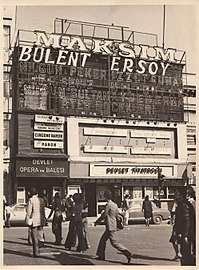
Back سينما تركية Arabic Türkiyə kinosu Azerbaijani Төркиә кинематографы Bashkir Cinema turc Catalan سینەمای تورکیا CKB Türkischer Film German Τουρκικός κινηματογράφος Greek Cine de Turquía Spanish سینمای ترکیه Persian Cinéma turc French
| Cinema of Turkey | |
|---|---|
 Maxim Night Club, previously Cinemajik Movie Theater in Taksim, Istanbul. | |
| No. of screens | 2,826 (2019) |
| • Per capita | 3.32 per 100,000 (2019) |
| Main distributors | CGV Mars Distribution 50.83% UIP 22.52% TME Films 14.43%[1] P-inema 5.37% |
| Produced feature films (2012)[2] | |
| Total | 61 |
| Number of admissions (2012)[2] | |
| Total | 43,935,763 |
| • Per capita | 0.8 (2016)[3] |
| National films | 20,487,220 (47.0%) |
| Gross box office (2012)[4] | |
| Total | $234 million |
| National films | $109 million (46.6%) |
| Part of a series on the |
| Culture of Turkey |
|---|
 |
| Languages |
| Mythology and folklore |
| Cuisine |
| Festivals |
| Religion |
| Art |
| Literature |
Cinema of Turkey or Turkish cinema (also formerly known as Yeşilçam, which literally means Green Pine in Turkish), (Turkish pronunciation: [ˈjeʃiltʃam]) or Türk sineması refers to the Turkish film art and industry. It is an important part of Turkish culture, and has flourished over the years, delivering entertainment to audiences in Turkey, Turkish expatriates across Europe, Balkans & Eastern Europe, also more recently prospering in the Arab world and to a lesser extent, the rest of the world.
The first film exhibited in the Ottoman Empire was the Lumière Brothers' 1895 film, L'Arrivée d'un train en gare de La Ciotat, which was shown in Constantinople (modern day Istanbul) in 1896. The Weavers (1905), by the Manaki brothers, was the first film made in the Ottoman Empire. The earliest surviving film made in what is present-day Turkey was a documentary entitled Ayastefanos'taki Rus Abidesinin Yıkılışı (Demolition of the Russian Monument at San Stefano), directed by Fuat Uzkınay and completed in 1914. The first narrative film in Ottoman Empire isn't known for certain. [5]
Turkey's first sound film Bir Millet Uyanıyor was shown in 1931.[6]Traditional Turkish theater had improvisation storytellers like Meddah, orta oyunu, Karagöz and Hacivat. Western storytelling drama format evolved, After Darülbedayi (1914) in Ottoman Empire and Ankara State Conservatory (1936) in Turkey, .[7][8][9] Due to their training format, Theater actors moved away from cinema or they only did dubbing in cinema. So, Turkish cinema started to evolve in 1960s. Yeşilçam era was the world's 4th biggest cinema.[10][11]
- ^ "Table 6: Share of Top 3 distributors (Excel)". UNESCO Institute for Statistics. Archived from the original on 17 January 2014. Retrieved 5 November 2013.
- ^ a b "Box-Office". General Directorate of Cinema. Archived from the original on 12 November 2013. Retrieved 12 November 2013.
- ^ "Annual Report 2016" (PDF). Union Internationale des Cinémas. Archived from the original (PDF) on 3 October 2016. Retrieved 16 June 2016.
- ^ "Market Study - Turkey" (PDF). German Films. Archived from the original (PDF) on 12 November 2013. Retrieved 9 November 2013.
- ^ https://www.iienstitu.com/blog/sinemanin-turkiyede-baslangic-yillari
- ^ https://ucuncusinema.com/ataturkun-rol-aldigi-film-bir-millet-uyaniyor/
- ^ https://www.gazetekadikoy.com.tr/kultur-sanat/tiyatronun-aynasinda-100-yil
- ^ https://adk.hacettepe.edu.tr/tr/menu/tiyatro_anasanat_dali-17
- ^ https://www.kulturportali.gov.tr/portal/geleneksel-turk-tiyatrosu
- ^ https://sinema.ktb.gov.tr/TR-144750/turkiye39de-sinema.html
- ^ https://www.milliyet.com.tr/cadde/dunya-sinemasi-turkce-izlenirken-1611308
© MMXXIII Rich X Search. We shall prevail. All rights reserved. Rich X Search